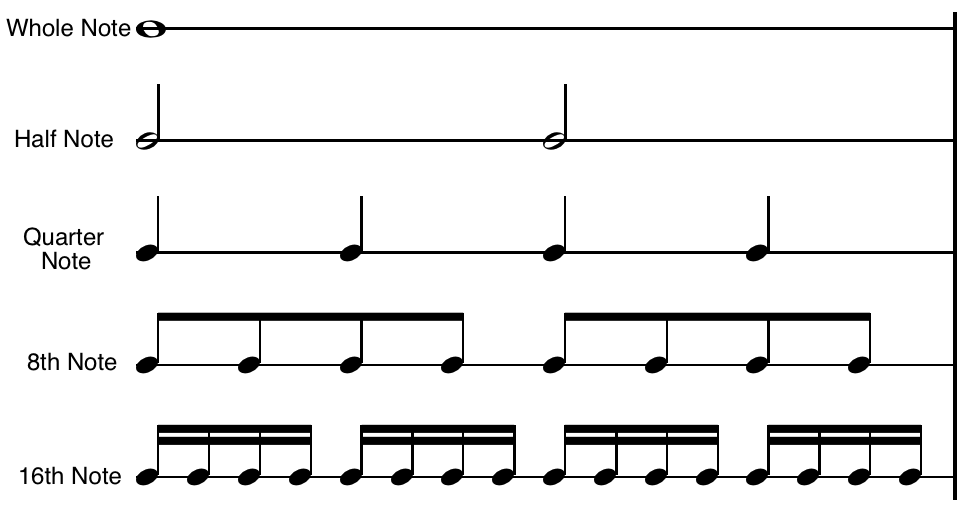Note Length
All notes in a song are usually related to the tempo mathematicaly. To build more complex rhythms, you just have to hold notes for different lengths of time. Some notes are held for multiple beats, and some notes are short enough to be played multiple times per beat. I’ll focus on five different note lengths.

The whole note is held for the longest. The half note is held for half the length of the whole note, so two half notes are equal in length to one whole note.
You could think of quarter notes as lasting one quarter of a whole note, or half of a half note.
An 8th note lasts half as long as a quarter note, and a 16th note lasts half as long as an 8th note.
Continuing this pattern of dividing by two, it’s possible to encounter 32nd notes and 64th notes as well, but these are less common.
The most important thing is to relate these note values to the tempo. Usually, we decide that the quarter note lasts one beat. So, when you set your metronome to any tempo, you could think of it as tapping out quarter notes, no matter how fast or slow you set the tempo. This means that half notes last for two beats, whole notes for four beats, 8th notes for half of a beat, and 16th notes for one quarter of a beat. If this is confusing, don’t think about it too much. Go ahead and listen to the examples and try playing them, then come back and read this again. It’s important not to get bogged down in thinking about music. Thinking must be balanced with playing, so get playing!
Note Length Exercise 1: From Whole Notes to 16th Notes
This is a beginner exercise for understanding the different note lengths. I wrote them out in piano notation, but you can do these exercises by tapping the floor with your foot and tapping a surface with your hand. Use your foot to tap out the bottom note at a medium tempo, so your foot will act as a metronome. Use your hands to tap the top notes. I ask you to do it this way because as you learn more and more complicated rhythms, you must keep the underlying tempo going at a steady speed. If you don’t, people will stop dancing, and they will be noticeably unimpressed. Tapping quarter notes with your foot forces you to be aware of the tempo at all times.
Whole Notes
Whole notes last four beats. On the first beat, your foot and hand tap at the same time, but your hand waits until the 5th beat to play again. The 5th beat can be thought of as the first beat being played again. It may help to count to four while playing this.

Half Notes
Might be even easier because you only have to count to two!

Quarter Notes
The easiest one. Just tap the tempo with your foot and your hand at the same time.

8th Notes
This one is harder. The first 8th note (and the 3rd, 5th, 7th, etc,) is played at the same time as the beat, but the second note (and the 4th, 6th, etc,) is placed exactly halfway between the two beats. If you are at all unsure about how this is supposed to sound, listen to the example below.

16th Notes
You might want to use two hands for this one. Tap the first note with your dominant hand, then alternate hands for every note. Your dominant hand will be playing 8th notes. Your non-dominant hand will be playing exactly halfway between all the notes your dominant hand is playing. Again, listen to the example below if you’re unsure.
